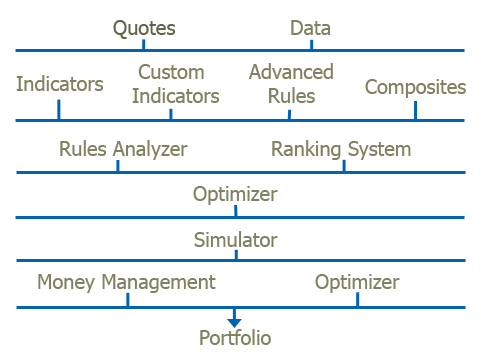 QuantShare offers many tools to assist you in backtesting your trading ideas. Data Before digging into the backtesting process, the first thing you will need is data. You will have to download historical quotes for the market you trade. You can also download any other financial data, including fundamental data, economic data, volume data, short selling data, commitment of traders, news... In the sharing server, you can find many downloaders already shared by our members or you can create your own. Rules Once you have your data downloaded and saved into your databases, you will have to create trading rules. For this, you can: - Use our library of +200 indicators - Create advanced rules formula (searchfor syntax) - Create custom indicators or download indicators from the sharing server - Create composite rules (Example: Stocks whose rate of change is higher than two times the standard deviation of the rate of change of all stocks) Analyze Rules can be stored using the Rules Manager plug-in. The same plug-in lets you analyze and backtest simple rules in search of the most profitable ones or the ones that achieve any goal you specify. For example, you can analyze several rules and search for the ones that are likely to increase the stocks' volatility. The ranking system plug-in calculates a value or score for each security given a set of nodes and formulas. Using this tool, you can implement and backtest ranking systems and then include the most profitable ones in your trading systems. Two popular optimization algorithms, Population-based incremental learning (PBIL) and Genetic algorithm (GA) can be used by the Optimizer plug-in to analyze multiple variations/combinations of your rules and ranking systems. Simulator Now that you have a set of profitable rules and a good ranking system, you can create a trading system using the Simulator plug-in of this trading software. This tool lets you specify several other settings, like the number of allowed position, whether the trading system takes long, short or long/short positions, stops... Advanced traders will love the money management tool; it allows them to test almost any strategy or trading idea. The optimization of a trading system can be performed using the exhaustive optimizer or the intelligent optimizer plug-in we have introduced earlier. For more information, please look at the documentation or read the following posts (Optimization of a trading system, Money Management: Optimize a trading system). Portfolio The backtesting process is a continuous process; you should always test and backtest new ideas, new systems and new rules. Once you are confident with a trading system, you can assign it to a portfolio and rebalance that portfolio to get new buy/sell/short/cover orders.
|

|
|
|
|







